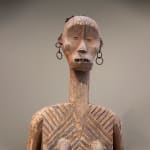Ntomba/Ndaka Anthropomorphic Reliquary (Coffin) , 19th to early 20th century CE
Wood
223 x 40 x 36 cm
87 3/4 x 15 3/4 x 14 1/8 in
87 3/4 x 15 3/4 x 14 1/8 in
GM.0060
Further images
-
(View a larger image of thumbnail 1
)

-
(View a larger image of thumbnail 2
)

-
(View a larger image of thumbnail 3
)

-
(View a larger image of thumbnail 4
)

-
(View a larger image of thumbnail 5
)

-
(View a larger image of thumbnail 6
)

-
(View a larger image of thumbnail 7
)

-
(View a larger image of thumbnail 8
)

-
(View a larger image of thumbnail 9
)

-
(View a larger image of thumbnail 10
)

Strictly speaking, this figure is a coffin, designed to contain the exhumed bones of a deceased ancestor. Made by the Ntomba (also known as the Ngata) people of the Congo...
Strictly speaking, this figure is a coffin, designed to contain the exhumed bones of a deceased ancestor. Made by the Ntomba (also known as the Ngata) people of the Congo region, these coffins (Bondange) were designed for two purposes: the first was to depict the characteristics of the deceased individual but, more importantly, to reflect their elevated status within the community. As a result, they tend to be very large, colourful, dramatically carved and elaborately decorated. Even by these standards, however, the current example is exceptional. It stands over two meters tall (223cm), and is carved from a single section of tree trunk. The figure is emphatically female, with pronounced breast and hollow back (to receive the remains of the deceased), gracile arms resting on the hip area, and short legs. The decoration consists of geometric patterns (multiple squares superimposed) coloured with red, white, and blue, against a plain-wood ground. The individual has a very long neck, surmounted by a highly stylised head. The configuration of the eyes, face and mouth is very distinctive; the quality of the carving is extremely high. The squared jaw is adorned with the remains of textiles originally firmed by studs, while the cheeks, nose, and forehead are adorned by linear carvings, possibly representing tattoos. The ears present on both sides triple hoop earrings. The condition of the figure seems to suggest that it was stored for a considerable period of time after manufacture. The significance of this is uncertain, but it has been noted that such coffins are usually ‘buried’ in rivers, which makes this specimen both uncommon and highly desirable. This is a stunning, important and imposing piece of African art that would grace any collection.









